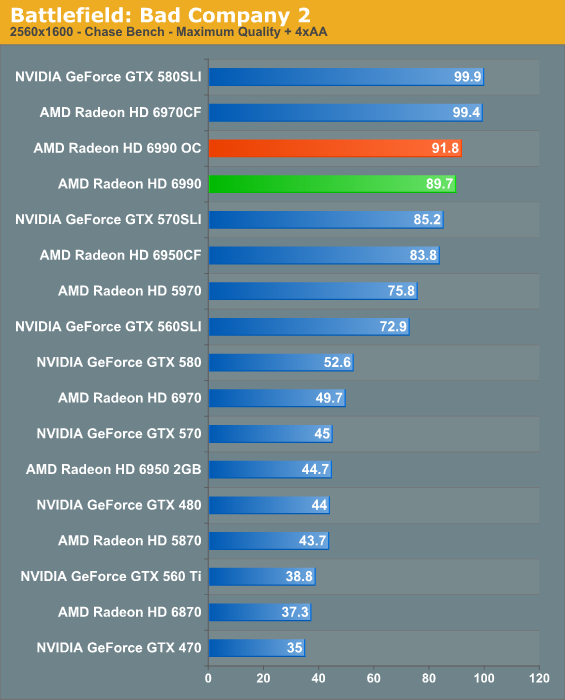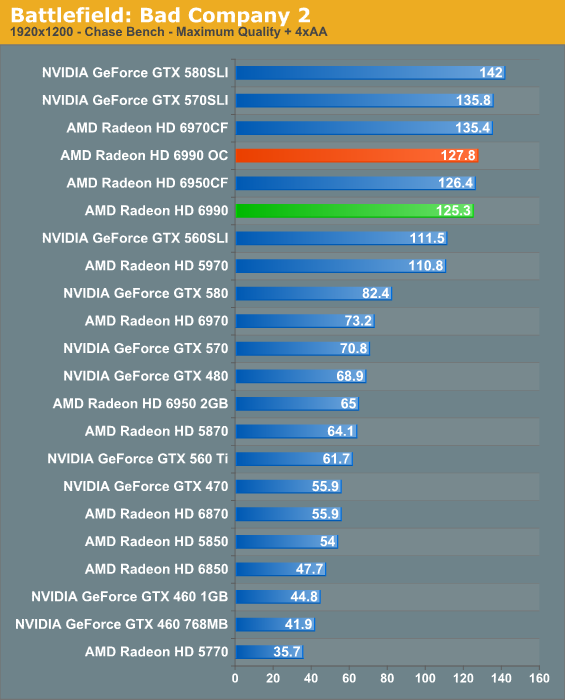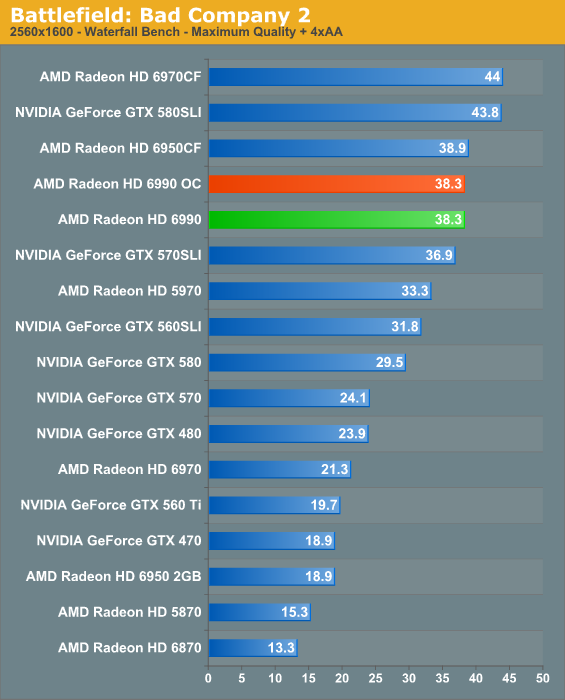AMD's Radeon HD 6990: The New Single Card King
by Ryan Smith on March 8, 2011 12:01 AM EST- Posted in
- AMD
- Radeon HD 6990
- GPUs
Battlefield: Bad Company 2
The latest game in the Battlefield series - Bad Company 2 – remains as one of the cornerstone DX11 games in our benchmark suite. As BC2 doesn’t have a built-in benchmark or recording mode, here we take a FRAPS run of the jeep chase in the first act, which as an on-rails portion of the game provides very consistent results and a spectacle of explosions, trees, and more.


Bad Company 2 ends up being another game heavily reliant on memory bandwidth, so once again the 6970CF takes a solid lead over the 6990, effectively matching the 10% memory bandwidth difference with 10% more performance. Interestingly the 6990 still has an edge on the 6950CF, showing that there’s more than 1 bottleneck with Bad Company 2. Meanwhile compared to the 5970 the 6990 once again takes a respectable lead of 18%. AMD is fortunate here though that the Radeons have an advantage in this game, as giving up 10% in performance almost anywhere else would be enough to fall below the GTX 570 SLI.

Our waterfall minimum framerate benchmark ends up being quite similar in order to our general chase benchmark. The 6990 is noticeably behind the 6970CF, and in fact it’s just a bit worse this time as the 6950CF edges out even the 6990OC. Memory bandwidth and PCIe bandwidth, take your pick, both play a part here.










130 Comments
View All Comments
Figaro56 - Tuesday, March 8, 2011 - link
I have 2 XFX HD 5870 cards for sale. I have a double lifetime warranty on these so you get the use of the second lifetime warranty on these. Interested? They are very great performers I can vouch for that. I am use to upgrading my GPU on an annual basis so I am upgrading to 2 HD 6970. $230 each.Thanny - Tuesday, March 8, 2011 - link
Ignoring the inappropriateness of advertising here, I submit:http://www.newegg.com/Product/Product.aspx?Item=N8...
Why would someone pay you $230 for a used product that can be obtained new at $190?
fausto412 - Tuesday, March 8, 2011 - link
I kinda wanted to see a chart with the most common gaming resolution...and can we benchmark with a Q9550 just for comparison? i would love to know if i'm holding back a video card by not going i5 or i7 and by how much.jabber - Tuesday, March 8, 2011 - link
If you can afford a 6990 why would you be bothering using it with a Q9550 at 1680x1050. Hence why it isnt part of this review.This review is to show how it works for the intended market/customer.
As I said before, this card isnt for folks like you (or me for that matter). Sorry.
7Enigma - Tuesday, March 8, 2011 - link
The most common gaming resolution for this card is the one Ryan tested. It is pointless to test at a lower resolution other than possibly true 24" (1920X1200). And even at that res this card is really not needed.Figaro56 - Tuesday, March 8, 2011 - link
BOYA to both of those resolutions. You should be playing your games at 2560x1600. Now that's what I'm talkin about! You'd be saying hell ya.Jorgisven - Tuesday, March 8, 2011 - link
It seems we're getting into the Pentium IV trap, a bit. Big, hot, power-hungry, noisy chips...personally, I'm going to pass on this generation of GPUs. I'm waiting for a revolution in either manufacturing or coding. It's all well and good to have a fast computer for getting what you need done in minimal, but at the risk of the box taking flight because the fans are now of jet engine proportion in speed and power, I'd rather not be able to hear my fans over my headphones...or risk my cat getting sucked into the intake.jabber - Tuesday, March 8, 2011 - link
Well we've kinda got what we asked for. We've all gamely been buying more and more powerful graphics cards with regards to brute force rendering power.We've shown we love buying 750w+ power supplies with multiple GPU connectors, buying SLI and Xfire setups galore.
So the GPU corps think we love nothing more than just piling on more and more power and wattage to solve the situation.
It works both ways.
What we should have been doing was challenging AMD and Nvidia to develop smarter rendering techniques. Had either of them developed PowerVR to the state we are in today we would be in a far better place. Chances are the most power hungry card we'd have today would be 5770 level.
We need something more efficient like PowerVR to take us to the next level.
Less brute force and more finesse.
therealnickdanger - Tuesday, March 8, 2011 - link
Are you waiting to update your test system until the SATA port issue is corrected? Seems to me that anyone wanting to buy this card would also be using an overclocked 2600K... According to the Bench numbers, the 2600K offers roughly 30% more frames than the 920, depending on the game. That indicates to me that your test system is insufficient to properly test this card.Granted, since the vast majority of displays are fixed at 60Hz, fps counts beyond that don't really matter, but I have to wonder what impact this would have on folks with 120Hz-native LCDs. That extra 30% could make the difference.
... just sayin'. :)
Ryan Smith - Tuesday, March 8, 2011 - link
At this point we're waiting on SNB-E. SNB is very nice, but for a GPU testbed the lack of PCIe bandwidth is an issue.